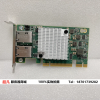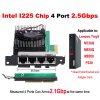So I have finally setup a m720q tiny to replace an old R210ii, with my ATT fiber line.
I wanted to share this info for anyone who wants to move to a m720q tiny who has 2.5/5/10gb AT&T fiber line.
I have AT&T 2.5gb fiber.
The ATT BWG320 is the fiber modem I have to use, which has a 5GB rj45 port.
I tried to use the SuperMicro AOC-STGN-i2s NIC by I cannot get it to negotiate a 5GB connection.
pfsense recognizes the NIC, but I just cannot get a connection between it and the modem.
i have tried multiple transceivers, and still cannot get it to work.
I Assume the problem is with the x520 chipset negotiating a 5GB connection, with a transceiver - if anyone knows one that works please let me know.
i then tried to fit in my x710-T2L - which is rj45 10/5/2.5 GB.
As I pulled it out I forgot what a LONG boy this is.
so I was initially crest fallen, assuming it would not fit..
upon trying to jam it in the m720q tiny, the only thing blocking it was this thin piece of metal at the front of the chassis, which luckily is secured by one tiny screw, and popped out very easily!
This piece of metal I removed:
After removing this, the i710-t2l FIT like a dream.
I don't have a rear plastic baffle as it appears nobody has done this, but no big deal as the card is so long it rests on the back of the far side front USB ports. It's literally a perfect fit. It's rock solid, doesn't wobble at all, and the case still closes.
Here's a pic of the huge NIC installed:
The case closes up, and it works like a dream!
Bonus over the Super micro AOC-STGN-i2s NIC, is the X710-t2l runs a lot cooler, and has a heatsink twice the size.
Side question, in the above image I highlighted what I think is an antenna in purple. Is it safe to remove that?
It was resting in the metal piece I removed, and is just kinda loose now. It appears to be secured under the WiFi card with a single screw.
Anyway, wanted to share for anyone who wants to move to a m720q tiny who has 2.5/5/10gb AT&T fiber.








